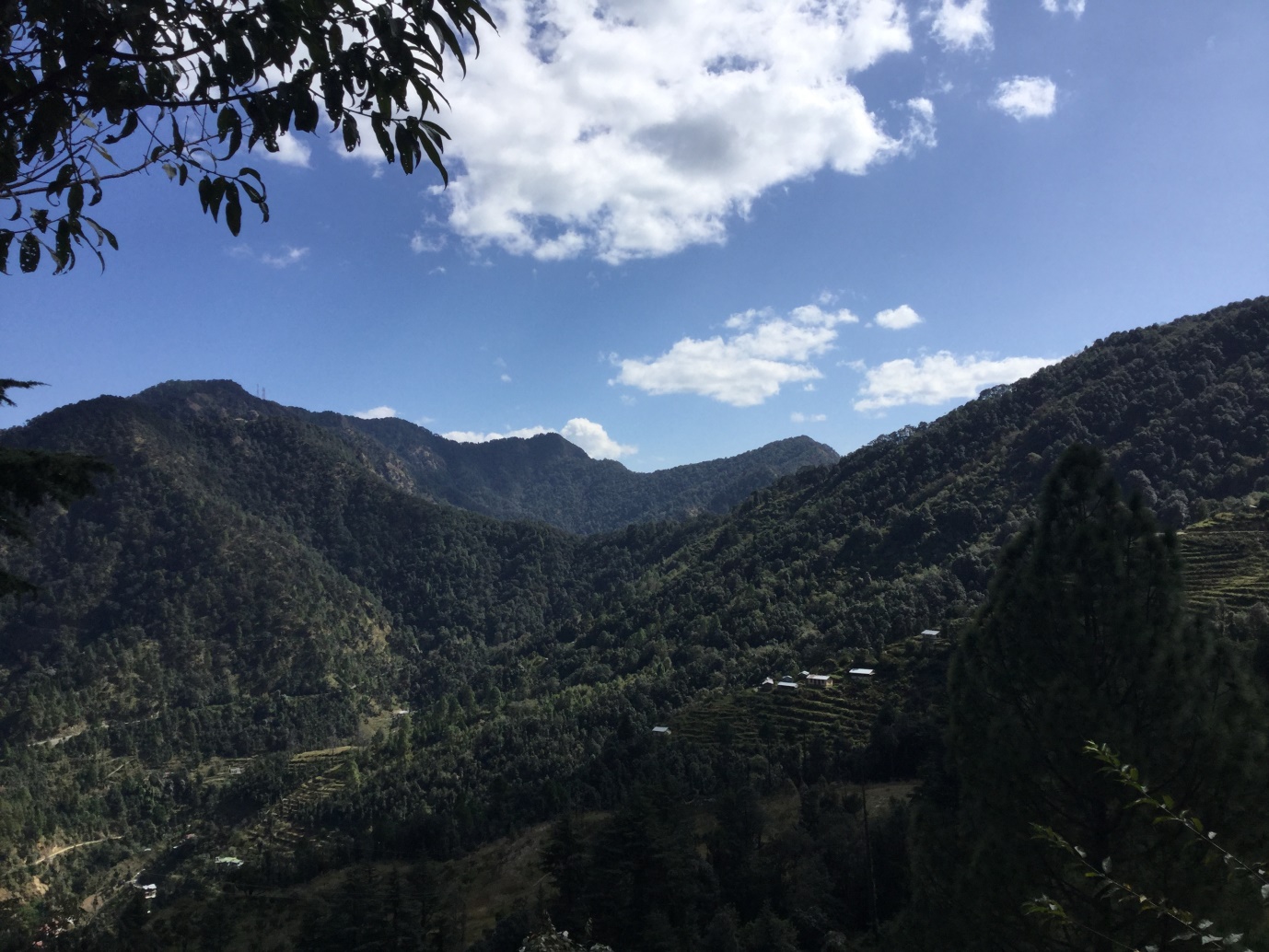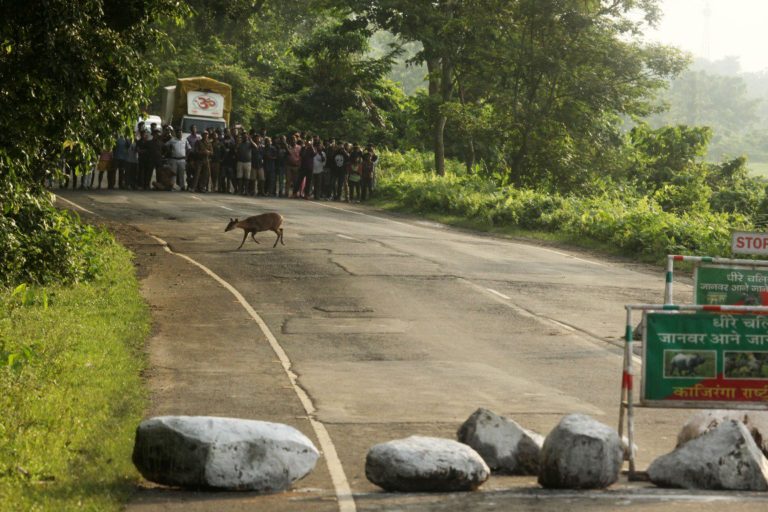
The monsoon floods that claimed over 100 human lives and displaced millions in India’s eastern and northeastern states, has submerged Kaziranga National Park (KNP) in flood-hit Assam, killing close to 200 of its animals.
As of July 22, as many as 199 animals perished in the national park, home to the world’s largest population of one-horned rhinoceros. Among the dead animals are 139 hog deers, 17 rhinos, one elephant, seven swamp deers, two water buffaloes, 13 sambars, 17 wild boars, and three porcupines.
The Kaziranga National Park and Tiger Reserve (KNP/KTR) located in the northeastern state of Assam, is sandwiched between the Brahmaputra River in the north and the verdant Karbi Anglong hills in the extreme south. Together they make up the 25,000-square-kilometer (9,650-square-mile) Kaziranga-Karbi Anglong Landscape.
The expansive grasslands, swamps and open jungle of the park, a UNESCO World Heritage Site, are home to more than 2,400 rhinos (Rhinoceros unicornis), 100 Bengal tigers (Panthera tigris tigris) and 1,100 elephants (Elephas maximus indicus).
During the fierce monsoons, when the Brahmaputra bursts its banks and floods Kaziranga’s grasslands, Karbi Anglong serves as a refuge for the wildlife that migrates over to the hills.
This year, a telling picture of the floods surfaced online: an adult female tiger resting on a bed inside a shop in Bagori range, in the western part of Kaziranga.
The tiger was attempting a cross-over to higher patches of the Karbi hills as the water level went up.
Veterinarians associated with Centre for Wildlife Rehabilitation and Conservation(CWRC) and forest department officials, who rushed to the spot, brainstormed for nine hours and facilitated a safe passage for the tiger back to the forest.

CWRC, an animal rescue centre for injured and orphaned animals, is jointly run by the Wildlife Trust of India (WTI), The International Fund for Animal Welfare (IFAW) and Assam forest department.
Veterinarian Samshul Ali from CWRC said it was the most natural thing for the tiger to do under the circumstance. “However, human settlements around the park made this passage difficult and so it entered the shop,” Ali said.
This incident was one among the numerous relentless ongoing rescue operations in Kaziranga conducted by the forest department with support from CWRC, local NGOs and people from fringe villages.
As many as 1400 forest department personnel alongside 300 to 400 people from nearby villages and NGOs are dedicatedly battling nature’s fury to provide a haven for the affected animals.
So far, 64 animals have been rescued in Kaziranga, including 53 hog deers, two rhinos, one elephant, one sambar, two swamp deers, and other reptiles and birds.
The park’s inundation has driven a shift to boats from four-wheelers as the most preferred mode of transport by the forest department.
P Sivakumar, Director of Kaziranga, said: “We have more than 200 country boats in addition to 11 speed boats or ‘bhotbhotis’ in the park. There are also 50 to 60 vehicles, but during monsoon, we mostly use boats,” he said.
Floods also cause frightened and agitated animals to behave aggressively, threatening the lives of forest frontline staff.
“These animals might be undergoing both physical and physiological stress. Behavioural stress (from fighting for space, sociological factors) leads to physiological stress. Many may be under nutritional stress as food might not be available easily,” G. Umapathy of the Centre for Cell and Molecular Biology, who studies animal stress responses, told Mongabay-India.
“In one incident at Kohora last week, a mahout named Farzul Islam was injured when a wild boar attacked his elephant. He fell from the elephant. He has been admitted to Jorhat Medical College and is now recovering,” said Sivakumar.
Kaziranga floods: Boon or bane?
Even though Kaziranga loses a sizeable chunk of its biodiversity to the floods every year, experts and forest officials consider the event as a ‘necessary evil.’
Rabin Sharma, Research Officer, Kaziranga National Park (KNP) observed that the floods flush out invasive flora and clean up the water bodies used by the park’s animals.
“Floods are essential for the smooth functioning of the park’s ecology. We have 92 permanent water bodies or beels inside the park which are filled with water throughout the year and thousands of species in the park use these water bodies. If there is no flood for two consecutive years, water in most of these beels will become unfit for drinking,” said Sharma.
The floods help to flush out invasive aquatic flora like water hyacinth, which chokes the water bodies and the Mimosa invisa (a relative of the touch-me-not M. pudica), which is toxic to herbivores on ingestion.
“If there is no flood, we will have to clear these weeds manually, which will cost crores of rupees,” Sharma told Mongabay-India.
The number of wildlife casualties is comparatively less this year. As recent as 2017, the death toll of animals in Kaziranga during floods had crossed 400.
Reduction in the death toll is being attributed to the construction of 33 new highlands by the forest department inside the park. Animals like rhinos, water buffaloes and hog deers have taken refuge in these patches of higher ground.
Sharma, however, said that the necessity of these highlands only arose because the corridor to natural highlands for the animals, i.e., the Karbi hills is blocked by shops, hotels and settlements.
“Ecologically, this is not a great intervention. We prefer not to intervene unless it is necessary. Highlands are required because animal corridors are blocked. Otherwise, Kaziranga and Karbi Anglong are part of a single landscape. During the flood, when water increases in Kaziranga, it is natural for animals to move to Karbi Hills seeking high ground,” Sharma said.
“Shops, dhabas, and hotels have cropped up on the highway blocking the animals’ passage to a large extent. Had the corridor been open, we wouldn’t need highlands,” Sharma said.
Firoz Ahmed, a wildlife biologist with Assam-based NGO Aaranyak said the animals migrate in large groups while crossing the road to the higher grounds and while returning to Kaziranga, the animals usually move in smaller numbers or as individuals.
India’s Transport Minister Nitin Gadkari recently cautioned that India being “a poor country”, a balance must be maintained in spending public money to protect the environment and development needs.
The landscape connectivity between Kaziranga and the Karbi Anglong hills, crucial for the survival of long-ranging species like Indian elephants and Bengal tigers, is also under threat from indiscriminate rock mining and quarrying and river erosion, according to a report by India’s National Tiger Conservation Authority (NTCA).
More than 40 stone quarries were operating in the hill slopes facing National Highway 37 that passes along the southern boundary of the national park.
But earlier this year India’s apex court ordered a ban on mining and construction activities along the southern boundary of the KNP and in the entire catchment area of rivers, streams and rivulets originating in the Karbi Anglong Hill Ranges and flowing into the KNP.
The prohibition has provided respite to the animals.
“The area is peaceful following the ban and this has facilitated free movement of animals to the highlands,” said KNP Director P. Sivakumar.
District authorities imposed restrictions (Section 144 of the Indian Penal Code) on vehicular movement along the national highway, to shield wild animals from traffic while escaping from the inundated forest swathes.
Rohini Ballav Saikia, Divisional Forest Officer (DFO), KNP, said the forest department issues time cards to regulate the speed of vehicles during monsoon to prevent incidents of roadkill. “If we catch anyone driving over the speed of 40 kilometre per hour between particular check-points, they are fined Rs 5000,” Saikia said.
Neglected cousins
While Kaziranga’s plight is deservedly getting a lot of attention, there is not much noise on the condition of some of the other major protected forests of Assam like Orang, Manas, Pobitora and Dibru Saikhowa.
“The flood narrative on wildlife is Kaziranga-centric. Even conservation efforts revolve around Kaziranga. One of the reasons is because of the politics around it,” explained Aaranyak’s Ahmed.
Pobitora Wildlife Sanctuary, known for having one of the highest densities of one-horned rhinoceros in the world, is also reeling under floods. It is located in Morigaon, which is one of the worst flood-hit districts this year.
Mukul Tamuly, Range Officer of Pobitora informed that 95 percent of the sanctuary is submerged.
“Out of our 24 forest camps, 22 have been affected badly. We have evacuated five camps. Our main office, staff quarters, guest house, everything is underwater. However, there is no report of any animal casualty so far. After the water recedes, we might get carcasses of some animals,” Tamuly told Mongabay-India.
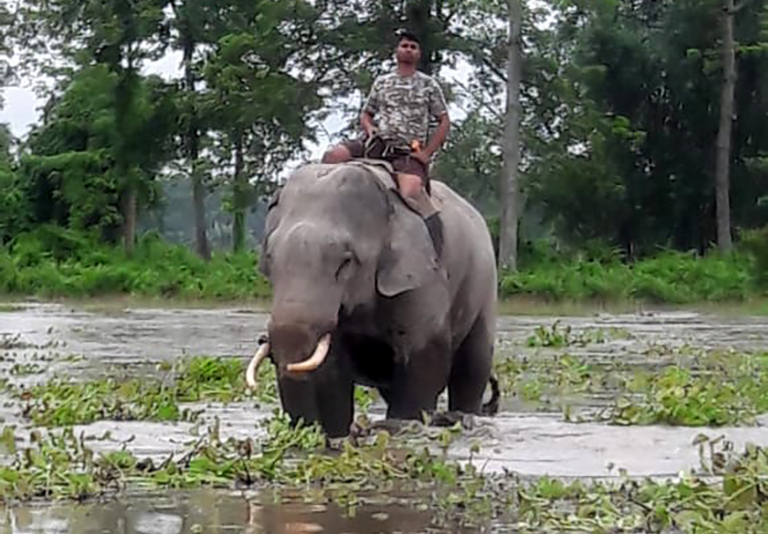
Pobitora has 148 frontline staff, including casual labourers. They also have 16 country boats and one speed boat. Tamuly said there are six highlands in the park where rhinos, wild buffaloes and wild boars have taken shelter.
Orang National Park is in a comparatively better position. Though initially, 70 percent of the park lay under water, the water level has receded now, and at present only 20 percent of the park is submerged.
Ramesh Gogoi, DFO, Mangaldoi, under whose jurisdiction Orang falls said, “Out of our 40 anti-poaching camps, 30 were affected. However, the damage was not big, and we didn’t need evacuation. The topography of Orang is such that water doesn’t remain for long.”
Six animal deaths have been reported in Orang so far-four hog deers, one pygmy hog and one porcupine. While one hog deer was killed for its meat, rest succumbed to drowning.
Amal Sarma, Director of Manas National Park said that the impact of flood in Manas has been minimal this year and there are no reports of animal deaths so far.
Sources said that a large chunk of Dibru Saikhowa is flooded. The park is a floodplain and is submerged every year but unlike Kaziranga, it doesn’t have highlands where animals can take shelter. The park is also grappling with the shortage of manpower with just 49 frontline staff to monitor the entire area of 334 sq km.
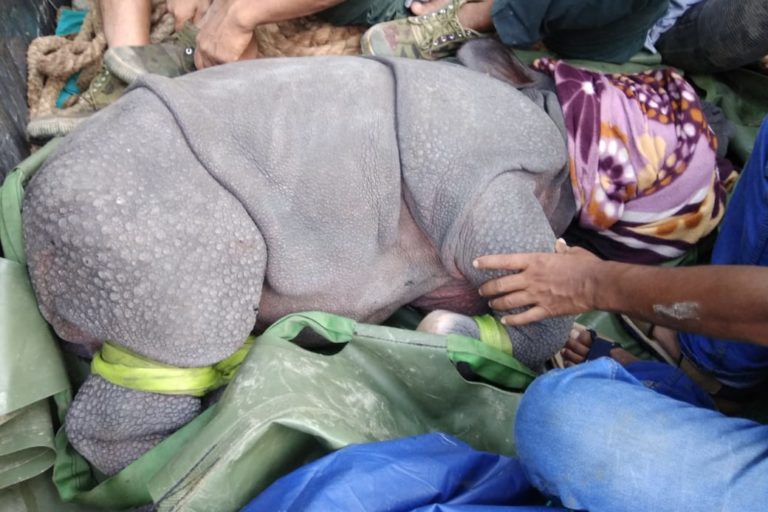
Guwahati-based engineer J N Khataniar said that people have to learn to live with floods which can’t be prevented.
He said: “Hills surround the whole of Assam. When heavy rainfall occurs, rushing water from hills generally flows downward towards the plains of Assam, triggering floods. Also, one peculiarity of this region is all the rivers along with the Brahmaputra carry high silt from hills. During floods, this silt is deposited over the bed of the rivers. Carrying capacity of rivers is reducing after every flood, and there is no method till date to increase the carrying capacity by removing silt.”
He categorically said that dredging of the river to clear the silt is not an option. “In Assam, even if you remove the silt from the river by dredging, it will be refilled by silt coming from hills in no time. So, the entire exercise of dredging will be futile,” he emphasised.
Professor Chandan Mahanta of IIT Guwahati‘s civil engineering department emphasised that addressing the challenge to manage the Brahmaputra requires the best brains from across the world.
“One has to understand that the Brahmaputra is not simply a large alluvial river but one of the most complex hydrological systems in the world. The system includes rainfall to a whole network of dynamic tributaries and more importantly the huge sediment load which is believed to be the highest in the world. That makes the options like dredging and effective flood control extremely challenging,” Mahanta said.
“We need the most competent brains from the global community for the Brahmaputra,” Mahanta told Mongabay-India. “It can be argued that the Brahmaputra is already a naturally degraded river because of landslide, erosion, sediment deposition and seismic activities. Because of the dynamics of sediment load, when you already have a sort of sick river you need to be more careful,” he said.
For instance, in 24 hours between July 19 and July 20, four earthquakes jolted Arunachal Pradesh, tremors of which were felt in Assam. “These four earthquakes may have changed the river from what it was 24 hours ago,” said Mahanta.
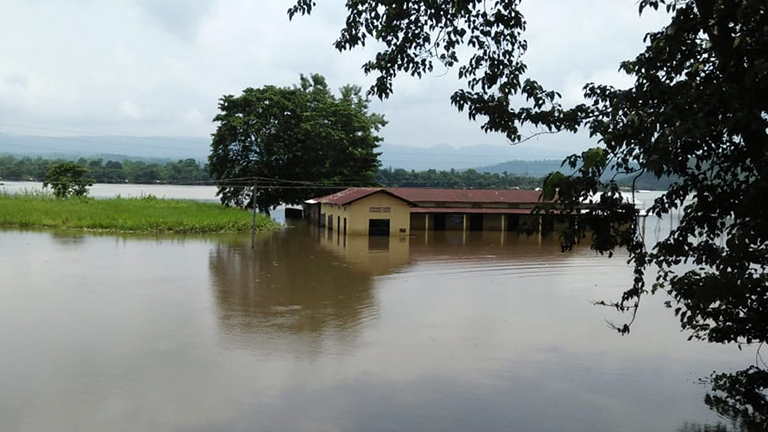
Khataniar has developed a floating house, which he said can be used by people from flood-prone areas of Assam, Bihar and West Bengal.
It is a pre-engineered light gauge steel frame structure (LGSFS) anchored to four posts and placed over plastic floating chambers. The structure moves upward without being displaced when floodwaters rush in. It comes back to its original position once floodwaters recede.
Khataniar said that the house could have provisions for bio-toilet, one storeroom, rainwater collecting chamber for drinking purpose and space to keep livestock.

This article is republished from Mongabay under a Creative Commons license. Read the original article.




